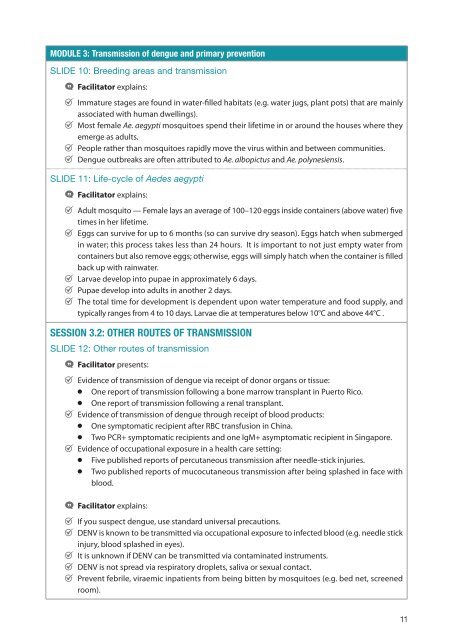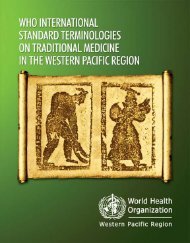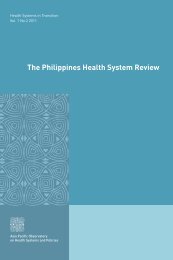Facilitator - WHO Western Pacific Region - World Health Organization
Facilitator - WHO Western Pacific Region - World Health Organization
Facilitator - WHO Western Pacific Region - World Health Organization
You also want an ePaper? Increase the reach of your titles
YUMPU automatically turns print PDFs into web optimized ePapers that Google loves.
MODULE 3: Transmission of dengue and primary prevention<br />
SLIDE 10: Breeding areas and transmission<br />
•<strong>Facilitator</strong><br />
•<br />
explains:<br />
•Immature stages are found in water-filled habitats (e.g. water jugs, plant pots) that are mainly<br />
•<br />
associated with human dwellings).<br />
•Most female Ae. aegypti mosquitoes spend their lifetime in or around the houses where they<br />
•<br />
emerge as adults.<br />
•Dengue outbreaks are often attributed to Ae. albopictus and Ae. polynesiensis.<br />
•<br />
•People rather than mosquitoes rapidly move the virus within and between communities.<br />
SLIDE 11: Life-cycle of Aedes aegypti<br />
•<strong>Facilitator</strong><br />
•<br />
explains:<br />
•Adult mosquito — Female lays an average of 100–120 eggs inside containers (above water) five<br />
•<br />
times in her lifetime.<br />
•Eggs can survive for up to 6 months (so can survive dry season). Eggs hatch when submerged<br />
in water; this process takes less than 24 hours. It is important to not just empty water from<br />
containers but also remove eggs; otherwise, eggs will simply hatch when the container is filled<br />
•<br />
back up with rainwater.<br />
•<br />
•Larvae develop into pupae in approximately 6 days.<br />
•<br />
•Pupae develop into adults in another 2 days.<br />
•The total time for development is dependent upon water temperature and food supply, and<br />
typically ranges from 4 to 10 days. Larvae die at temperatures below 10°C and above 44°C .<br />
SESSION 3.2: OTHER ROUTES OF TRANSMISSION<br />
SLIDE 12: Other routes of transmission<br />
•<strong>Facilitator</strong><br />
•<br />
presents:<br />
•<br />
•Evidence of transmission of dengue via receipt of donor organs or tissue:<br />
OO<br />
One report of transmission following a bone marrow transplant in Puerto Rico.<br />
OO<br />
One report of transmission following a renal transplant.<br />
•Evidence of transmission of dengue through receipt of blood products:<br />
•<br />
OO<br />
One symptomatic recipient after RBC transfusion in China.<br />
OO<br />
Two PCR+ symptomatic recipients and one IgM+ asymptomatic recipient in Singapore.<br />
•Evidence of occupational exposure in a health care setting:<br />
OO<br />
Five published reports of percutaneous transmission after needle-stick injuries.<br />
OO<br />
Two published reports of mucocutaneous transmission after being splashed in face with<br />
blood.<br />
•<strong>Facilitator</strong><br />
•<br />
explains:<br />
•<br />
•If you suspect dengue, use standard universal precautions.<br />
•DENV is known to be transmitted via occupational exposure to infected blood (e.g. needle stick<br />
•<br />
injury, blood splashed in eyes).<br />
•<br />
•It is unknown if DENV can be transmitted via contaminated instruments.<br />
•<br />
•DENV is not spread via respiratory droplets, saliva or sexual contact.<br />
•Prevent febrile, viraemic inpatients from being bitten by mosquitoes (e.g. bed net, screened<br />
room).<br />
11

















